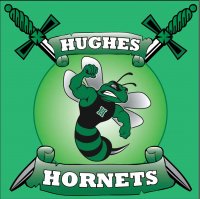Creating College spirit and culture is very important to us here at Good Shepherd. To ensure that this flourishes we have four Houses: Fenton, Hughes, Livingstone and Strauss.
In the Senior School, the House ethos has been extended whereby the wellbeing is structured in what is called a ‘Vertical House System’. This means that Senior School students have their wellbeing needs taken care of by not only class teachers, but House Home Group teachers and House Coordinators.
Student leadership exists under this structure whereby there are two Year 12 students elected to the position of House Captain.
Fenton House

Fenton was named after one of the WWII airstrips in the area. Fenton airstrip was named after Clyde ‘Doc’ Fenton, the Territory’s flying doctor.
Fenton won the College House Shield in 2007, 2010, 2013, 2014, 2015, 2016 and 2017!
- More about Fenton
-
Fenton was born in Warrnambool, Victoria in 1901. In 1935 Fenton was appointed to the NT Medical Service. From 1942-1945 he served in the RAAF as a flight instructor. Clyde Fenton survived the war and died in Melbourne, 28 February 1982.
The first air raid on Fenton airfield was carried out on 30 June 1943. Two men were injured, four liberators were destroyed and much equipment was lost. In the air a total of six spitfires were lost and one pilot was killed. Post war disposals saw a large part of the wreckage disappear as the scrap dealers smelted down the aircraft into ingots. In recent years, souvenir hunters have removed much of what was left.
Hughes House

Huges was named after Mr W Hughes, the Director of Mines in Darwin who during early 1942 suggested a site for the Aerodrome Development Program
Hughes won the College House Shield in 2011 and 2012.
- More about Hughes
-
During early 1942, Flight Lieutenants, Yeaman and Brogan were involved in the selection progress of the Aerodrome Development Program. Mr W Hughes, the Director of Mines in Darwin at the time suggested a site 30 miles from Darwin. The site was selected and subsequently named after him. The airfield’s construction was finished and in full operation by May 1942.
Since the airfield’s construction there has been considerable confusion as to who, exactly the airfield was named after. Early US and RAAF sources suggest that it was named after 2nd Lieutenant Charles W Hughes (one of the American men killed in Darwin on February 19 1942). Four air raids on Hughes were carried out by the Japanese in 1942, 13 and 19 August and 26 and 27 November. Loads of ammunition and equipment were lost as a result of the raids.
Livingstone House

Livingstone airstrip was named after Lieutenant John D Livingstone, a Lieutenant that belonged to the 9th Squadron of the 49th Pursuit group.
Livingstone won the College House Shield in 2008 and 2018.
- More about Livingstone
-
Livingstone died in a landing accident on 4 April 1942 after being wounded during action over Darwin. Livingstone managed to fly to the closest air- strip, however crashed on the southern overrun. Livingstone was buried at the Garden’s Cemetery two days later. Livingstone airstrip was one of the first roadside fighter strips to be completed under the Aerodrome Development Program.
Livingstone airstrip also had a camp attached to it. It was originally established as a tented camp in March 1942, however advanced to be a more civilized camp by having furniture, beds, mattresses and other handy materials trucked out from the Darwin Hotel.
Strauss House

Strauss airstrip was named after Captain Allison W Strauss, an American pilot who helped defend Australia during the Second World War.
Strauss won the College House Shield in 2009, 2019 and 2020.
- More about Strauss
-
Captain Allison W Strauss was born on 25 March 1916 in Youngtown Ohio. As a result of the Great Depression he moved from Ohio to Indiana. Strauss joined the air force in Texas and graduated as 2nd Lieutenant.
He was firstly sent to the Philippines, however was later stationed near Adelaide River. Strauss’ squadron was moved to the ‘27 mile airstrip’ (27 miles from Darwin) soon after Strauss was sadly shot down over Fannie Bay and killed on 27 April 1942. The ‘27 mile airstrip’ then became ‘Strauss Airstrip’. Strauss airstrip was the second of three roadside fighter strips. Between the 19 March and 27 April 1942, the 808th Engineer Aviation Battalion built the 5,000 by 2,000 feet airstrip.

